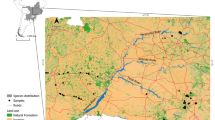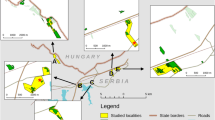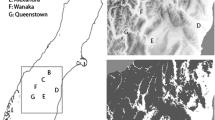Abstract
Aposematic organisms have warning signals advertising their unpalatability to predators, and because signal efficiency is better in higher densities, positive frequency-dependent selection is expected to select against less common signals. The wood tiger moth (Parasemia plantaginis) occurs across the Holarctic and its conspicuous hindwings serve as warning signals to predators. It also has conspicuous black and white forewing patterns that could act as warning signals, or help to hide the moth by preventing predators from seeing the outline of the moth’s body (a strategy known as disruptive coloration). In Alaska, the predominant forewing pattern changes distinctly between the regions around Fairbanks and Anchorage, suggesting local predators may maintain differences if the pattern functions as a warning signal. Alternatively, restricted gene flow along with drift could be responsible. We placed artificial moths with both local dominant and foreign forewing patterns in each of the two regions to test if predators select against the foreign forewing types, which would suggest the warning signal function of forewing patters. We also manipulated the level of disruptiveness in the forewing patterns to see if disruptiveness works in concert with the warning signal. The locally dominant forewing type was better protected in Fairbanks, but not in Anchorage where morphs were attacked equally. Manipulating the level of disruptiveness in the forewing pattern did not influence predation. Population genetic analyses from specimens caught during fieldwork showed the existence of two populations and restricted gene flow. Our results suggest that positive frequency dependent selection may be partially responsible for maintaining local signal differences, although predators seem to avoid both forewing patterns in Anchorage. Restricted gene flow between the two populations could be attributed to a combination of selection against foreign morphs in Fairbanks and physical barriers, which both likely contribute to warning signal differences in Alaska.




Similar content being viewed by others
References
Adams J, Kang C, June-Wells M (2014) Are tropical butterflies more colorful? Ecol Res 29:685–691
Aronsson M, Gamberale-Stille G (2012) Colour and pattern similarity in mimicry: evidence for a hierarchical discriminative learning of different components. Anim Behav 84:881–887
Benson WW (1972) Natural selection for Müllerian mimicry in Heliconius erato in Costa Rica. Science 176:936–939
Bohlin T, Tullberg BS, Merilaita S (2008) The effect of signal appearance and distance on detection risk in an aposematic butterfly larva (Parnassius apollo). Anim Behav 76:577–584
Bohlin T, Gamberale-Stille G, Merilaita S et al (2012) The detectability of the colour pattern in the aposematic firebug, Pyrrhocoris apterus: an image-based experiment with human ‘predators’. Biol J Linn Soc 105:806–816
Borer M, Van Noort T, Rahier M et al (2010) Positive frequency-dependent selection on warning color in alpine leaf beetles. Evolution 64:3629–3633
Brodie ED (1993) Differential avoidance of coral snake banded patterns by free-ranging avian predators in Costa Rica. Evolution 47:227–235
Buse A, Dury S, Woodburn R et al (1999) Effects of elevated temperature on multi-species interactions: the case of Pedunculate Oak, Winter Moth and Tits. Funct Ecol 13:74–82
Chapuis MP, Estoup A (2007) Microsatellite null alleles and estimation of population differentiation. Mol Biol Evol 24:621–631
Chouteau M, Angers B (2012) Wright’s shifting balance theory and the diversification of aposematic signals. PLoS One 7:e34028
Cott HB (1940) Adaptive coloration in animals. Methuen and Co., London
Cuthill IC (2006) Color perception. In: Hill GE, McGraw KJ (eds) Bird coloration: function and evolution: Harvard University Press, Cambridge, pp. 3–40
Cuthill IC, Stevens M, Sheppard J et al (2005) Disruptive coloration and background pattern matching. Nature 434:72–74
Dakin EE, Avise JC (2004) Microsatellite null alleles in parentage analysis. Heredity 93:504–509
Earl D, vonHoldt B (2012) STRUCTURE HARVESTER: a website and program for visualizing STRUCTURE output and implementing the Evanno method. Conserv Genet Resour 4:359–361
Edmunds M (1974) Defense in animals: a survey of anti-predator defenses. Longman Inc., New York
Eeva T, Veistola S, Lehikoinen E (2000) Timing of breeding in subarctic passerines in relation to food availability. Can J Zool 78:67–78
Endler JA (1988) Frequency-dependent predation, crypsis and aposematic coloration. Philos Trans R Soc Lond B 319:505–524
Endler JA, Mappes J (2004) Predator mixes and the conspicuousness of aposematic signals. Am Nat 163:532–547
Evanno G, Regnaut S, Goudet J (2005) Detecting the number of clusters of individuals using the software structure: a simulation study. Mol Ecol 14:2611–2620
Galarza JA, Viinikainen SM, Ashrafi R et al (2010) First microsatellite panel for the Wood Tiger Moth (Parasemia plantaginis). Consv Genet Resour 3:197–199
Galarza JA, Nokelainen O, Ashrafi R, Hegna RH, Mappes J (in press) Temporal relationship between genetic and warning signal variation in the aposematic wood tiger moth (Parasemia plantaginis). Mol Ecol
Gehara M, Summers K, Brown JL (2013) Population expansion, isolation and selection: novel insights on the evolution of color diversity in the strawberry poison frog. Evol Ecol 27:797–824
Goodale MA, Sneddon I (1977) The effect of distastefulness of the model on the predation of artificial batesian mimics. Anim Behav 25(Part 3):660–665
Ham A, Ihalainen E, Lindström L et al (2006) Does colour matter? The importance of colour in avoidance learning, memorability and generalisation. Behav Ecol Sociobiol 60:482–491
Hart NS, Partridge JC, Cuthill IC (2000) Retinal asymmetry in birds. Curr Biol 10:115–117
Hegna RH, Nokelainen O, Hegna JR et al (2013a) To quiver or to shiver: increased melanization benefits thermoregulation, but reduces warning signal efficacy in the wood tiger moth. Proc R Soc Lond B 280:20122812
Hegna RH, Saporito RA, Donnelly MA (2013b) Not all colors are equal: predation and color polytypism in the aposematic poison frog Oophaga pumilio. Evol Ecol 27:831–845
Hubisz MJ, Falush D, Stephens M et al (2009) Inferring weak population structure with the assistance of sample group information. Mol Ecol Resour 9:1322–1332
Ihalainen E, Lindström L, Mappes J (2007) Investigating Mullerian mimicry: predator learning and variation in prey defences. J Evol Biol 20:780–791
Ihalainen E, Rowland HM, Speed MP et al (2012) Prey community structure affects how predators select for Müllerian mimicry. Proc R Soc Lond B 279:2099–2105
Joron M, Iwasa Y (2005) The evolution of a Müllerian mimic in a spatially distributed community. J Theor Biol 237:87–103
Kapan DD (2001) Three-butterfly system provides a field test of mullerian mimicry. Nature 409:338–340
Lindstedt C, Eager H, Ihalainen E et al (2011) Direction and strength of selection by predators for the color of the aposematic wood tiger moth. Behav Ecol 22:580–587
Lindström L, Alatalo RV, Lyytinen A et al (2001) Strong antiapostatic selection against novel rare aposematic prey. Proc Natl Acad Sci USA 98:9181–9184
Lindström L, Alatalo RV, Lyytinen A et al (2004) The effect of alternative prey on the dynamics of imperfect Batesian and Mullerian mimicries. Evolution 58:1294–1302
Madsen T (1987) Are juvenile grass snakes, Natrix natrix, aposematically coloured? Oikos 48:265–267
Mallet J, Barton NH (1989) Strong natural selection in a warning-color hybrid zone. Evolution 43:421–431
Meglecz E, Petenian F, Danchin E et al (2004) High similarity between flanking regions of different microsatellites detected within each of two species of Lepidoptera: parnassius apollo and Euphydryas aurinia. Mol Ecol 13:1693–1700
Merilaita S, Lind J (2005) Background-matching and disruptive coloration, and the evolution of cryptic coloration. Proc R Soc Lond B 272:665–670
Nokelainen O (2013) Many forms of the wood tiger moth (Parasemia plantaginis): selective heterogeneity favours polymorphic warning signals. Jyväskylä Stud Biol Environ Sci 1456-9701 259:1–52
Nokelainen O, Hegna RH, Reudler JH et al (2012) Trade-off between warning signal efficacy and mating success in the wood tiger moth. Proc R Soc Lond B 279:257–265
Nokelainen O, Valkonen J, Lindstedt C et al (2014) Changes in predator community structure shifts the efficacy of two warning signals in Arctiid moths. J Anim Ecol 83:598–605
Noonan BP, Comeault AA (2009) The role of predator selection on polymorphic aposematic poison frogs. Biol Lett 5:51–54
Osorio D, Vorobyev M (2005) Photoreceptor sectral sensitivities in terrestrial animals: adaptations for luminance and colour vision. Proc R Soc Lond B 272:1745–1752
Owen DF, Smith DAS, Gordon IJ et al (1994) Polymorphic Müllerian mimicry in a group of African butterflies: a re-assessment of the relationship between Danaus chrysippus, Acraea encedon and Acraea encedana (Lepidoptera: Nymphalidae). J Zool 232:93–108
Peakall R, Smouse PE (2006) GENALEX 6: genetic analysis in Excel. Population genetic software for teaching and research. Mol Ecol Notes 6:288–295
Poulton EB (1890) The colours of animals: their meaning and use especially considered in the case of insects. Kegan Paul, Trench, Trübner, & Co. Ltd. London
Pritchard JK, Stephens M, Donnelly P (2000) Inference of population structure using multilocus genotype data. Genetics 155:945–959
Richards-Zawacki CL, Yeager J, Bart HPS (2013) No evidence for differential survival or predation between sympatric color morphs of an aposematic poison frog. Evol Ecol 27:783–795
Ricklefs RE (2009) Aspect diversity in moths revisited. Am Nat 173:411–416
Rousset F (2008) genepop’007: a complete re-implementation of the genepop software for Windows and Linux. Mol Ecol Resour 8:103–106
Rowe C, Lindström L, Lyytinen A (2004) The importance of pattern similarity between Müllerian mimics in predator avoidance learning. Proc R Soc Lond B 271:407–413
Rowland HM, Ihalainen E, Lindström L et al (2007) Co-mimics have a mutualistic relationship despite unequal defences. Nature 448:64
Ruxton GD, Sherratt TN, Speed MP (2004) Avoiding attack: the evolutionary ecology of crypsis, warning signals and mimicry. Oxford University Press, Oxford
Schaefer HM, Stobbe N (2006) Disruptive coloration provides camouflage independent of background matching. Proc R Soc Lond B 273:2427–2432
Schemske DW, Mittelbach GG, Cornell HV et al (2009) Is there a latitudinal gradient in the importance of biotic interactions? Annu Rev Ecol Evol Syst 40:245–269
Sherratt TN (2006) Spatial mosaic formation through frequency-dependent selection in Müllerian mimicry complexes. J Theor Biol 240:165–174
Sherratt TN, Rashed A, Beatty CD (2005) Hiding in plain sight. Trends Ecol Evol 20:414–416
Siddiqi A, Cronin TW, Loew ER et al (2004) Interspecific and intraspecific views of color signals in the strawberry poison frog Dendrobates pumilio. J Exp Biol 207:2471–2485
Stevens M (2007) Predator perception and the interrelation between different forms of protective coloration. Proc R Soc Lond B 274:1457–1464
Stobbe N, Schaefer HM (2008) Enhancement of chromatic contrast increases predation risk for striped butterflies. Proc R Soc Lond B 275:1535–1541
Svádová K, Exnerová A, Štys P et al (2009) Role of different colours of aposematic insects in learning, memory and generalization of naïve bird predators. Anim Behav 77:327–336
Tullberg BS, Merilaita S, Wiklund C (2005) Aposematism and crypsis combined as a result of distance dependence: functional versatility of the colour pattern in the swallowtail butterfly larva. Proc R Soc Lond B 272:1315–1321
Valkonen J, Niskanen M, Björklund M et al (2011) Disruption or aposematism? Significance of dorsal zigzag pattern of European vipers. Evol Ecol 25:1047–1063
van Bemmelen J (1918) The wing-marking of Arctiidae. Koninklijke Nederlandse Akademie van Weteschappen Proc Ser B Phys Sci 20:849–860
Van Oosterhout C, Hutchinson WF, Wills DPM et al (2004) Micro-checker: software for identifying and correcting genotyping errors in microsatellite data. Mol Ecol Notes 4:535–538
Veselý P, Luhanová D, Prášková M et al (2012) Generalization of mimics imperfect in colour patterns: the point of view of wild avian predators. Ethology 119:138–145
Vorobyev M, Osorio D (1998) Receptor noise as a determinant of colour thresholds. Proc R Soc Lond B 265:351
Vorobyev M, Osorio D, Bennett ATD et al (1998) Tetrachromacy, oil droplets and bird plumage colours. J Comp Physiol A 183:621–633
Wilson GA, Rannala B (2003) Bayesian inference of recent migration rates using multilocus genotypes. Genetics 163:1177–1191
Acknowledgments
We would like to thank Jonathan Hegna for valuable assistance in carrying out the experiment and collecting specimens throughout Alaska. Atsushi Honma and Janne Valkonen provided valuable input on the design of the experiment. Derek Sikes, Kenelm Philip, James Kruse, Michelle Michaud, and Dayna Dominguez assisted in locating suitable areas for the experiment and locating suitable specimen collecting areas. We thank Eira Ihalainen, Janne Valkonen, Juan Galarza, and Swanne Gordon for comments on earlier versions of this manuscript that significantly improved its quality. This work was conducted under US Fish and Wildlife Service permit KN-11-001, a scientific permit from Alaska State Parks, permit FH11-III-002-SA from the Alaska Department of Fish and Game. Funding was provided by the Academy of Finland (Finnish Centre of Excellence program, project 252411) and Biological Interactions Graduate School.
Author information
Authors and Affiliations
Corresponding author
Electronic supplementary material
Below is the link to the electronic supplementary material.
Rights and permissions
About this article
Cite this article
Hegna, R.H., Mappes, J. Influences of geographic differentiation in the forewing warning signal of the wood tiger moth in Alaska. Evol Ecol 28, 1003–1017 (2014). https://doi.org/10.1007/s10682-014-9734-7
Received:
Accepted:
Published:
Issue Date:
DOI: https://doi.org/10.1007/s10682-014-9734-7




